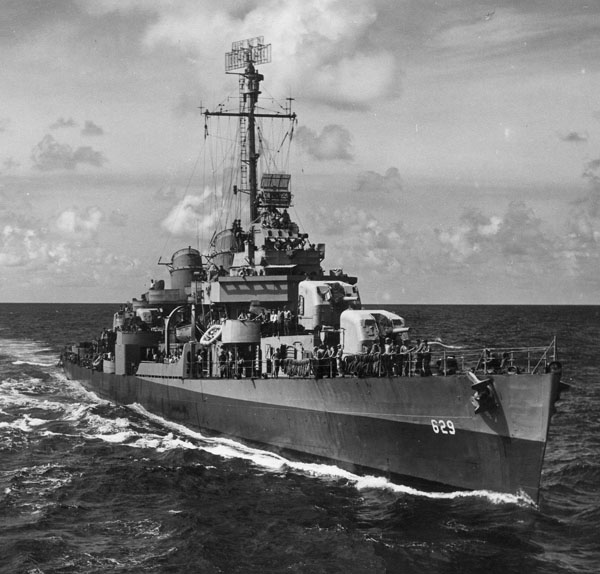Fletcher-class Destroyers
Abbot’s Camouflage
|
5-U
White |
BK
Black |
5-D
Dark Grey |
5-S
Sea Blue |
5-P
Pale Grey |
|
5-N
Navy Blue |
5-O
Ocean Grey |
5-L
Light Grey |
5-H
Haze Grey |
20-B
Deck Blue |
One simple question is not easy to answer: What color was Abbot?
Most of the surviving photographs are in black and white, but it is still obvious that Abbot changed colors several times during World War II and again after re-commissioning in the 1950s and ’60s.
The U.S. Navy used many different camouflage techniques, called measures, during World War II. Each measure was numbered, and each paint color had a name and number. Generally, hulls had different colors than decks. On some destroyers exotic dazzle or wavy patterns were used, and on others just a liberal coating of dark blue-gray.
Some of the most common World War II colors are shown in the chart above. Rather than try to explain all Fletcher camouflage schemes, only Abbot’s three schemes are explained below. Links to excellent sources for naval camouflage information are listed at the bottom of this page, and examples can be seen on the main Fletcher page.
No matter which camouflage measure was used, most surface warships shared certain features. A stripe of very dark or black antifouling paint known as boot-topping, which hid oil stains and discouraged the growth of barnacles, was generally used at the waterline; this coating was known as Mare Island 145A and it contained copper oxide and possibly mercury oxide in a plastic-like paint. An efficient dark red antifouling paint that contained copper oxide was employed on the bottom of the hull. This color was known as Norfolk 65-5F or 65A, but it would not normally be seen when the ship was at sea.
In the recent photo at right, Abbot’s sister ship Kidd is seen in Measure 22 camouflage (used 1944 to 1945) with the boot-topping barely visible between the red antifouling keel paint and the prominent navy blue stripe. Abbot did not have a logo on its forward stack until the 1960s, and in 1944 to 1945 its hull number was painted in white near the bow along the border between the navy blue stripe and the haze gray (see photo below) but otherwise the appearance is identical.
The early dark blue — almost purple — camouflage schemes were notoriously susceptible to oxidation and fading, so after a few months ships with Measure 21 often appeared to be painted with a lighter shade of blue. The navy began to run short of blue pigment toward the end of the war, causing a shift to grayer colors such as Measure 22.
Here is the chronology of Abbot’s camouflage in World War II:
- Early 1943 Abbot was launched wearing Measure 21: Navy Blue 5-N with Deck Blue 20-B decks. In black-and-white photos, the white hull numbers appears on a solid dark background, and the overall shade of the ship is uniformly dark.
- Late 1943 to late 1945 After Abbot collided with the aircraft carrier Cowpens in October 1943, it was repainted. Abbot wore Measure 22, with Navy Blue 5-N from the boot-topping to the height of the main deck edge at its lowest point. Everything above that was Haze Gray 5-H. This had the effect of splitting the white hull number, which can be easily seen in photos; the lower half of the hull number was painted over Navy Blue and the upper half was painted over the much lighter Haze Gray. The decks were Deck Blue 20-B.
- Late 1945 Abbot was repainted in Measure 13, probably in Bremerton, Washington, shortly after Japan surrendered. Photos taken later in San Diego show an overall light gray, Haze Gray 5-H, with the black boot-topping just visible above the waterline. Today, this is widely thought of as the classic navy wartime coloring scheme because of its many appearances in movies and its resemblance to post-war colors.
U.S.S. Abbot camouflage 1943-1945



Sources:
shipcamouflage.com
Battleships and Cruisers
Snyder & Short Enterprises